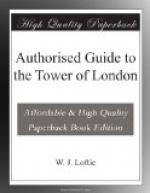The Middle Tower (Pl. I)
was originally built by Henry III, but has been entirely refaced. Through its archway we reach the stone bridge, which had formerly in the centre a drawbridge of wood. We next reach
The Byward Tower (Pl. II),
the great Gatehouse of the Outer Ward. It is in part the work of Henry III, and in part that of Richard II. Observe the vaulting and the dark recesses on the southern side. We pass on the left
The Bell Tower (Pl. IX),
which may safely be attributed to the reign of King John. Here Fisher, Bishop of Rochester, was imprisoned by Henry VIII, and the Princess Elizabeth by her sister, Queen Mary. The “Curtain Wall,” of great antiquity, is pierced by the windows of the Lieutenant’s Lodgings, now called “The King’s House,” and one of these windows lights the Council Chamber, where Guy Fawkes and his fellow conspirators were tried and condemned, 1605.
The Traitors’ Gate (Pl. IV),
with St. Thomas’s Tower, is now on our right. Observe the masonry which supports the wide span of the arch. This gate, when the Thames was more of a highway than it is at present, was often used as an entrance to the Tower. St. Thomas’ Tower was built by Henry III, and contains a small chapel or oratory dedicated to St. Thomas of Canterbury. In later times it was found convenient as a landing place for prisoners who had been tried at Westminster; and here successively Edward Duke of Buckingham (1521), Sir Thomas More, Queen Anne Boleyn, Cromwell Earl of Essex, Queen Katharine Howard (1542) Seymour Duke of Somerset (1551), Lady Jane Grey, the Princess (afterwards Queen) Elizabeth, Devereux Earl of Essex (1601), and James Duke of Monmouth, passed under the arch on their way to a prison or the scaffold. Opposite is
The Bloody Tower (Pl. VIII),
which is believed to derive its name from the suicide in it of Henry Percy, eighth Earl of Northumberland, in 1585. Under this Tower we enter the Inner Ward. It dates from the reigns of Edward III and Richard II, and was called by its present name as early as 1597, being popularly believed to be the scene of the murder of Edward V and his brother the Duke of York, as well as of Henry VI. It was originally known as the Garden Tower, as its upper storey opens on that part of the parade ground which was formerly the Constable’s Garden. Here Sir Walter Raleigh was allowed to walk during his long imprisonment, and could sometimes converse over the wall with the passers-by. Observe the grooves for working the massive portcullis, which was raised by chains and a windlass. These still exist on the upper floor. Immediately adjoining the gateway on the east is the
Wakefield Tower (Pl. III).




